Master of Orion (1993) - A 4X Masterpiece
Published: 2023-03-12 | Updated: 2023-06-10
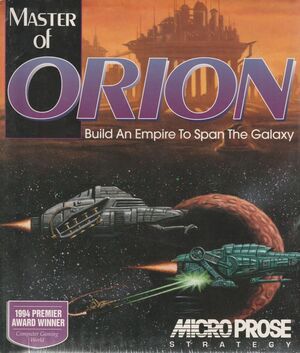
Master of Orion 1 (or MOO as I will refer to it from now on), is 30 years old this year. Developed by Simtex (headed by Stephen Barcia, who also developed Master of Magic) and published by MicroProse (headed by Sid Meier, Bill Stealey and Andy Hollis, internally developing and/or publishing numerous strategy games, such as Sid Meier’s Civilization and XCOM: Enemy Unknown) in 1993, this game remains as one of the finest strategy games of all time.
Why is this?
The short answer
The short answer lies in both its simplicity and its tightness as a game. MOO, while appearing complex at first glance, is remarkably simple and is ruthless in stripping down a 4X strategy game to its very core essentials. There’s no superfluous mechanics, time-wasting filler and micromanagement, MOO puts as much focus on pure big picture strategy. This combined with a few innovative twists such as the tech tree, and keeping player agency limited but not restrictive, makes this a fantastic game to play, all these years later.
The long answer
For a more detailed answer, I’m going to explore further the simplicity of the game contained and how said simplicity (and reduced complexity!) makes the game out above other, still fantastic 4X/Strategy games, such as the Civilization series, Endless Space 2, even the other MOO installments such as the sequel.
On the surface, the game is complex. The planetary management sidebar has a whole bunch of sliders and buttons to click, there’s concepts of different of planet environments - some habitable and some uninhabitable, the tech tree has all sorts of exotically named techs e.g. Enhanced Eco Restoration, Reduced Industrial Waste 80% and Improved Robotic Controls III, and the ship designer tab… well its a dizzying mess of options. Some mechanics (e.g. Espionage, others?) are not really explained at all in-game (this was the age where you’d get a big instructional booklet external to the game itself, and to its credit, that booklet is very in-depth). Despite this though, the learning curve is very short relative to other strategy games.
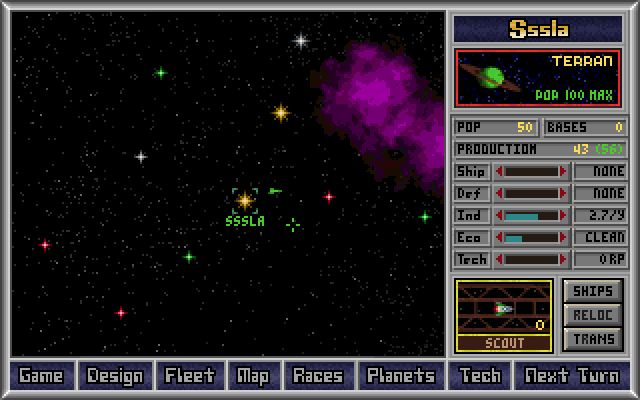
The planetary management sidebar gives key information at the top, such as current population and production output. Below that, the sliders dictate where that production goes: either ships (scout, colony or warships), planetary defences, industry (to get more production), waste cleanup/pop growth or research (get new technology). On top of that, the production formula is dead simple (1 BC per factory worked, 0.5 BC per pop point), meaning that understanding planetary management is dead simple. Build factories and grow pop early, and once maxed out, pour production (what’s left over post-waste-cleanup, factories produce pollution atfer all!) where you see fit. Each planet is flexible in this way, and so your empire can turn on a dime depending on the needs of the day. Further below that, you can choose what ship to produce in queue (and produce many at a time!), set up a RELOCate/go-to order for said ships, and TRANSport/move population (which doubles as a way to move population interally and externally i.e. ground invasions). All this can be managed in once place, and whilst on the map to boot! Colony, and hence empire management is easy, simple with concepts and dense with information, which is a recurring theme throughout.
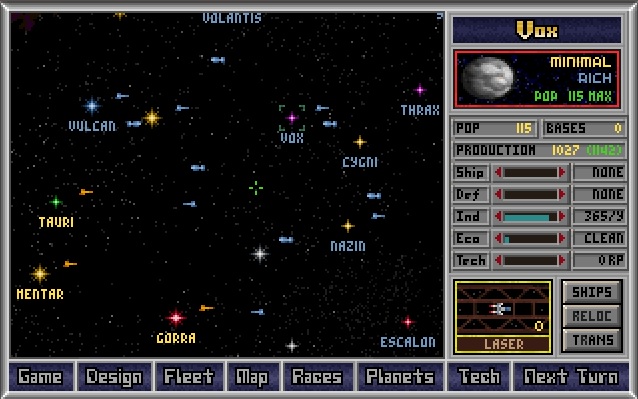
So there’s an aspect where the game is simple and consise. How about exploring an area where the game is fabulously innovative? Take a look at the tech tree - although it functions more akin to a tech ‘ladder’, where techs are grouped by rungs, and the player must obtain a tech in a rung to advance forward to the next successive rung. However, what techs are present at each rung are RANDOMIZED (coinflip chance each time, with at least one tech guaranteed per rung), meaning what is available for research is different from one game to the next. The lack of availability of all technologies means yourself (and rival AI empires!) will have strengths and weaknesses in certain areas, and there are numerous ways to resolve it. Do you try trading with another AI? Good luck, the AI is stingy and they propose technology deals, not you. How about stealing from another AI? Effective but diplomatically very risky. Do you push further in one section of the tech tree that would fix that weakness? You certainly can, but there’s never a guarantee, and other areas of research will suffer as a result. Lastly, you can just accept the weakness and make do with the tools you’ve been given. The Technology tree as a mechanic, like so many other mechanics, deliberately limits your options, while Diplomacy and Espionage offer partial solutions to said limitations.
To compensate for this tech tree design, the game once again simplifies a lot of the technologies down to a handful of core technology groupings, with successive upgrades, and a few unique specials here and there. Once you know what Improved Industrial (II) 9 or what Battle Computer (BC) I does or gives, you know exactly what II6 or BC VI does or gives also for free, so the game simplifies down where necessary in order to make the tech rung concept shine.
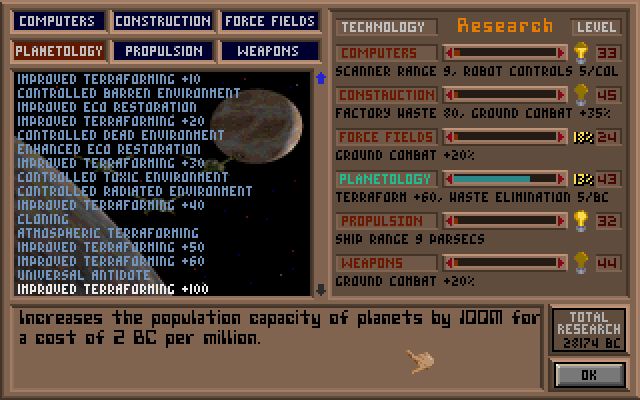
Finally, lets go over the win conditions, or rather, singular (!) win condition. Once 2/3rds of the Galaxy has been colonised, and every 25 turns subsequently, the Galactic Council meets. This is a system where the top two empires, in population, are nominated, and each empire votes (either picking a side or abstaining). If one empire gets 2/3rd’s of the vote, that empire wins and the game is over (technically there’s Final War, but I don’t really count that). So each meeting is an opportunity to either win, lose or prolong the game, and the limitation of just this victory conditions leads to some interesting dynamics. One dynamic is that diplomacy is always important to pay attention to, to ensure you don’t lose the upcoming vote. However, what if you have above 1/3rd of the population? You have a veto block, and while maintained ensures you can never lose a given election! But similarly, so can the AI, and means that you can never win a given election under those circumstances. Above all, however, the Galactic Council serves as a great way to cash in a win from a winning position, and quickly. I’ve not detailed it here but getting a tech edge and fleet supremacy can quickly snowball into conquering planet after planet after planet with just some simple methodical planning. This boosts your own population, reduces the AIs and does likewise in the Galactic Council voting. Got over 2/3rds of all population? You can simply vote yourself the winner, there and then, with minimal fuss. Getting a 4X to recognise a win from a winning position can be an absolute slog, but MOO is more than happy to hand it to you at the earliest opportunity.
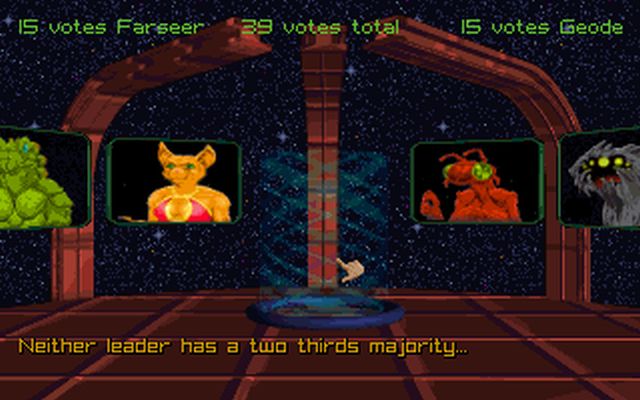
I could go into even more mechanics in great detail, however I’ll just give brief notes about some which I feel are worth calling out:
- Planetary Reserve - planets can put production into the Planetary Reserve, a empire-wide stockpile, and then it can be spent on other planets as your standard speed-up-production mechanic. Simple, but production but into stockpile is halved as a penalty, and production on a planet can only be doubled for a turn. Flexible enough to boost growth here and there, but prevents great fleets appearing out of thin air above newly founded colonies.
- Planet Habitability - many types of planets are habitable (i.e. colonisable) at the start of the game. Many however aren’t, and require tech to unlock. Sometimes you have a friendly neighbourhood with nice habitable planets, and sometimes you don’t, forcing you to invest in tech earlier. It also means colonisation is periodic rather than a one-and-done thing, which is neat.
- AI Diplomacy/Trading - as alluded to before, the AI is stingy in its diplomacy and calls the shots. Want a tech? They’ll decide what tech of yours they want in return. Try to get around by repeatedly offering different techs or deals? They’ll get irritable and close off comms. Sometimes they just don’t want to talk to you, it happens. Diplomacy is still powerful, but its far less susceptible to being gamed, a la Civilization and its trade screen (e.g. Optimally playing Civ III requires dialling up every AI every turn for trades! Exhausting)
- AI Personalities, “Erratic” - each AI personality has two traits, and each race has a “stock” duo of traits it traditionally picks. However, each game has a small chance of picking a different personality, and one of them is Erratic. It does what you’d expect, make the AI erratic, and said AI will declare war, quite literally based on periodic dice rolls. Surely this would be terrible for a strategy game, right? Well, no because you know the AI’s traits when you meet them, and so can determine well ahead of time not to trust said AI as far as you can throw them. Diplomacy (while honestly being the weakest mechanics) does largely work as intended, and friends can be found, so throwing a wildcard AI into the mix can certainly shake things up for the better - just ensure defenses are prepared ahead of time!
- Cold War - not entirely unique (I’ve played ES2 which has this, and its great there too), but battles can be fought whilst not actively at war. A large-scale conflict will get hot quickly, but there’s no reason two empires couldn’t remain at uneasy peace while unofficially skirmishing over planets and trying to establish, or dislodge, fledgling colonies.
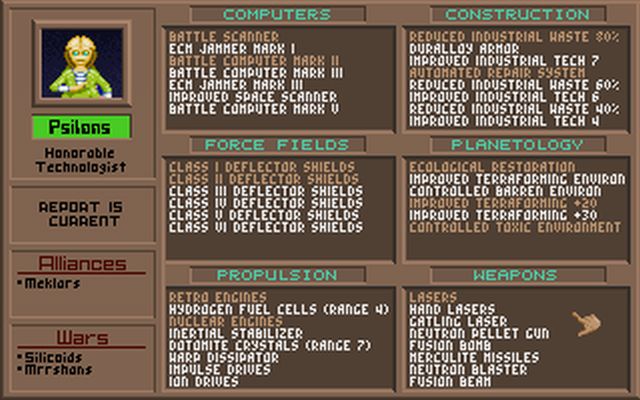
edit: I didn’t even go into detail about the ship designer! This is the most complicated screen of them all, but its where you get to use all sorts of technology and convert your planets economic base directly into fleet strength/space supremacy, and almost everything can be poured into a ship design either directly (weapons for damage, shields and armour for resisting damage, engines for movement) or indirectly (every tech contributes to miniaturization - im abstract terms each new tech unlocked subsequently makes older techs in the same research group cheaper and smaller to fit onto ships, hence “miniaturization”). It ties in well with the randomized tech tree, since you can mix-and-match and tailor your fleet depending on the situation, and while the combinations may be numerous - there’s generally just a few different potential ways a ship can contribute: scouting (gather knowledge of planets in galaxy), colonization (get planets under your empire’s flag), fleet-to-fleet (to attack other rival fleets) or bombers (to remove static planetary defences).
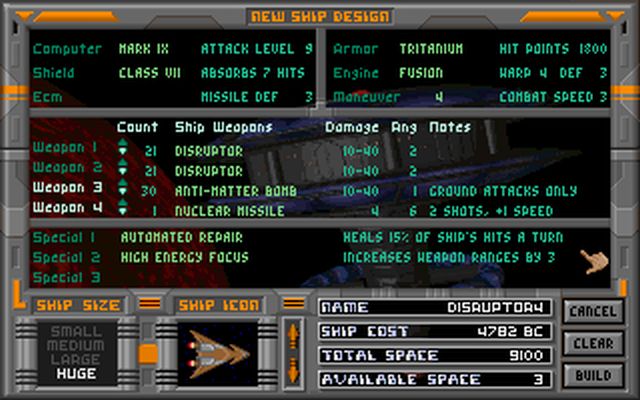
Nitpicks/Conclusion
As much as I love this game, there are some minor nitpicks with the original game, but the only real weak link in all of the mechanics is AI-to-AI diplomacy, willing to sign and break and sign alliances once more at the slighest of whims, leading to AIs getting outposts on planets it doesn’t deserve, and very occasionally letting an AI cheese an early diplomatic victory via the Galactic Council, early enough to where you don’t have contact with all (or any!) AI’s to try and influence the results. But this is admittedly rare, and if this is the best criticism I can come up with? That speaks volumes about how well this game holds up, all these years later. There are fan-patches around floating about adding QoL updates and making the AI a ‘lil smarter, but the game standalone, in all of its 320x240 DOS glory, is absolutely worth playing.
Finding resources or guides for a game this old can be difficult but there are a few floating about: good examples would be on Sullla’s website (who introduced me to this game through these writeups), as well as Sirian’s website here (in wayback-machine form) and some writeups on the LP archive. The game itself can likely be floating online for free, or can be purchased at Good Old Games bundled with its sequel for just a few pounds, an absolute bargain.
Updated 2023-06-10 to include extra paragraph and add images